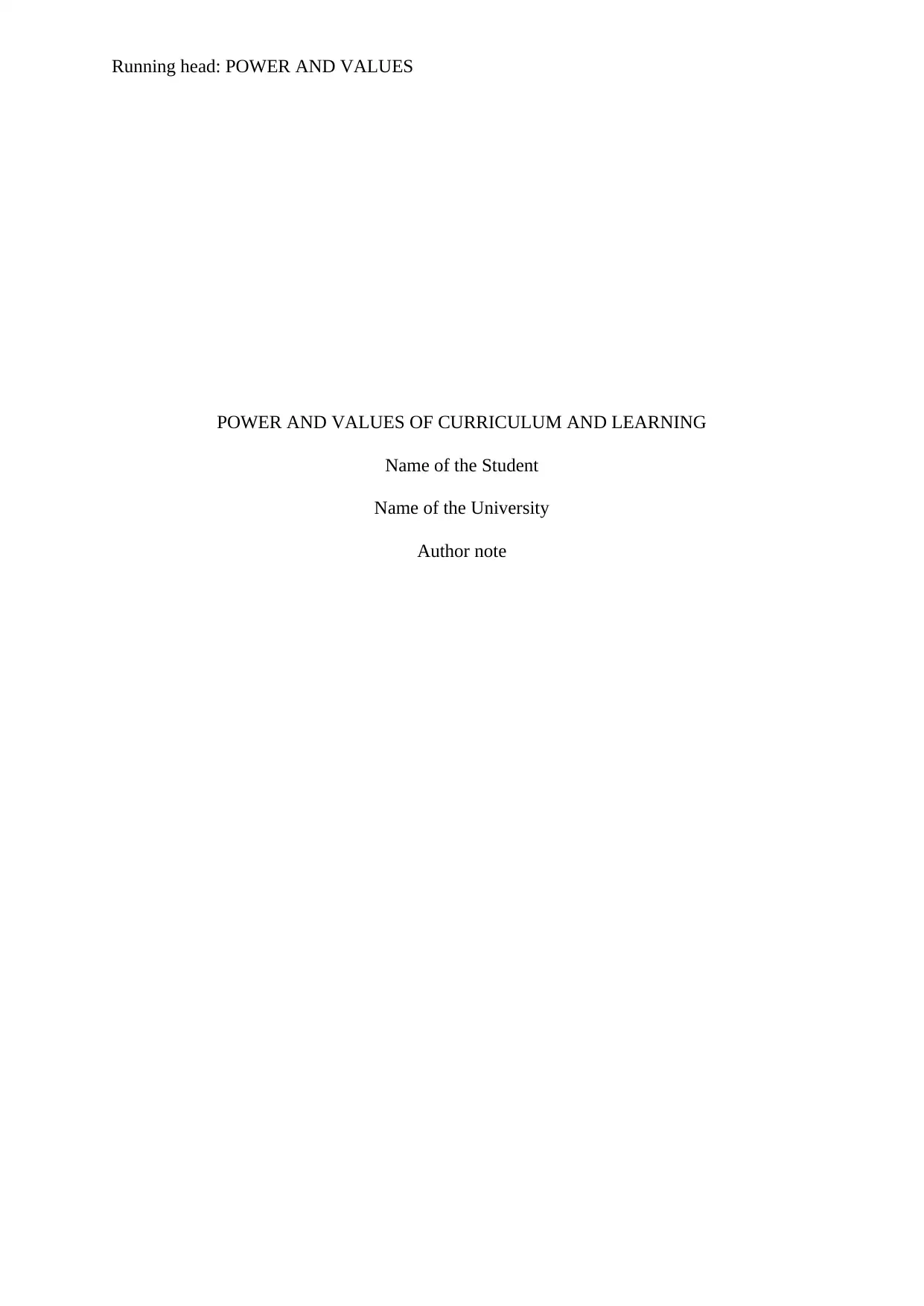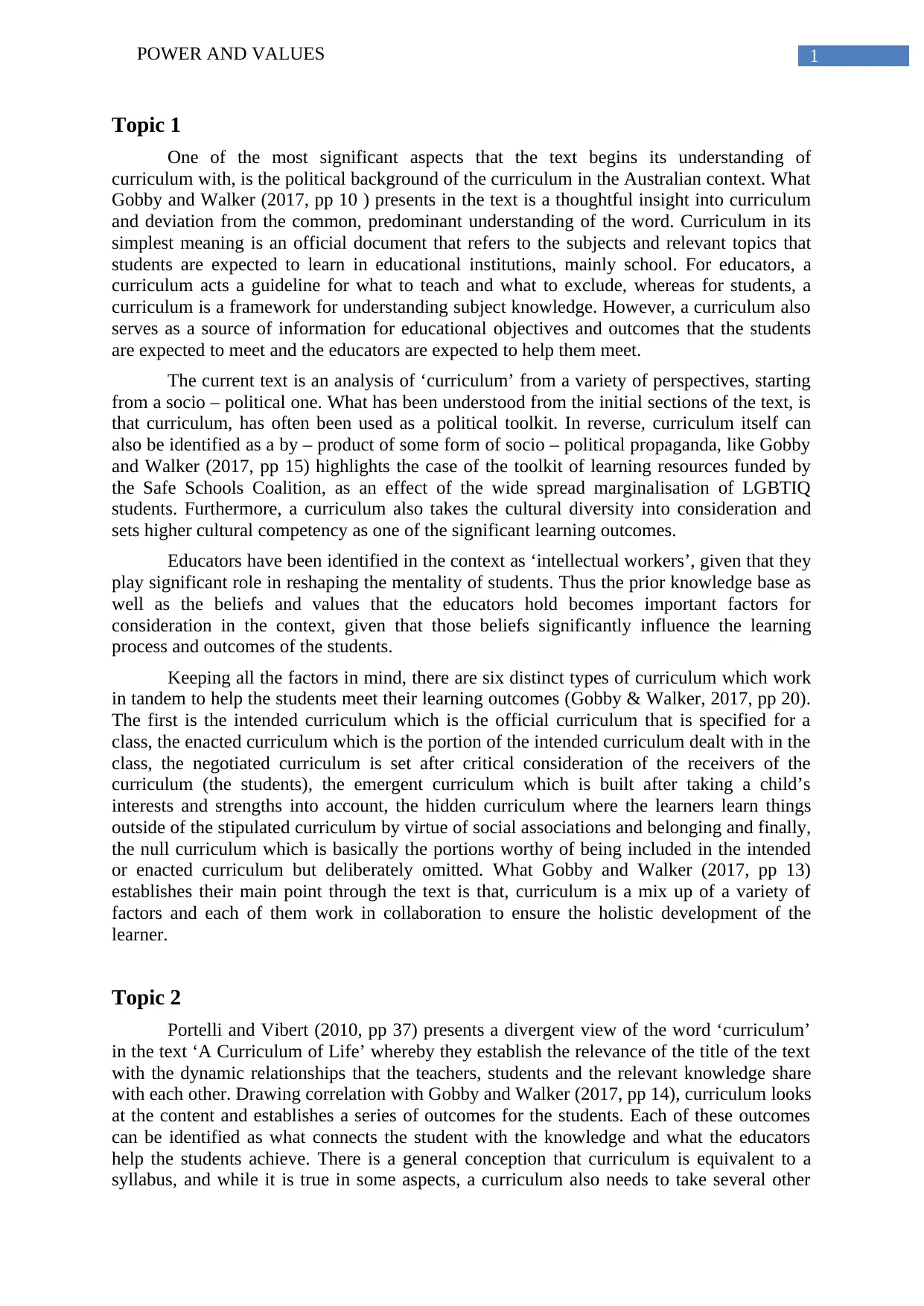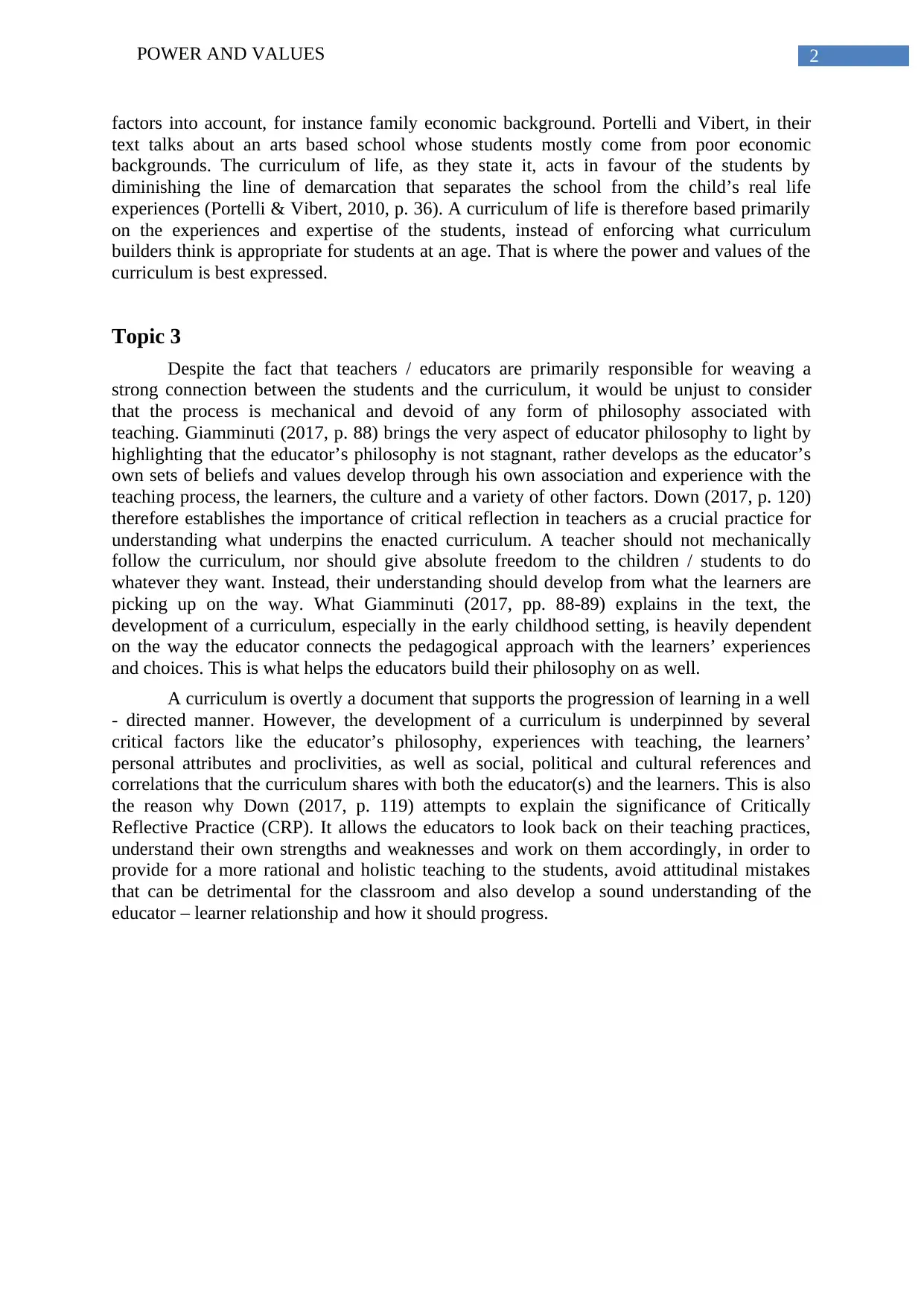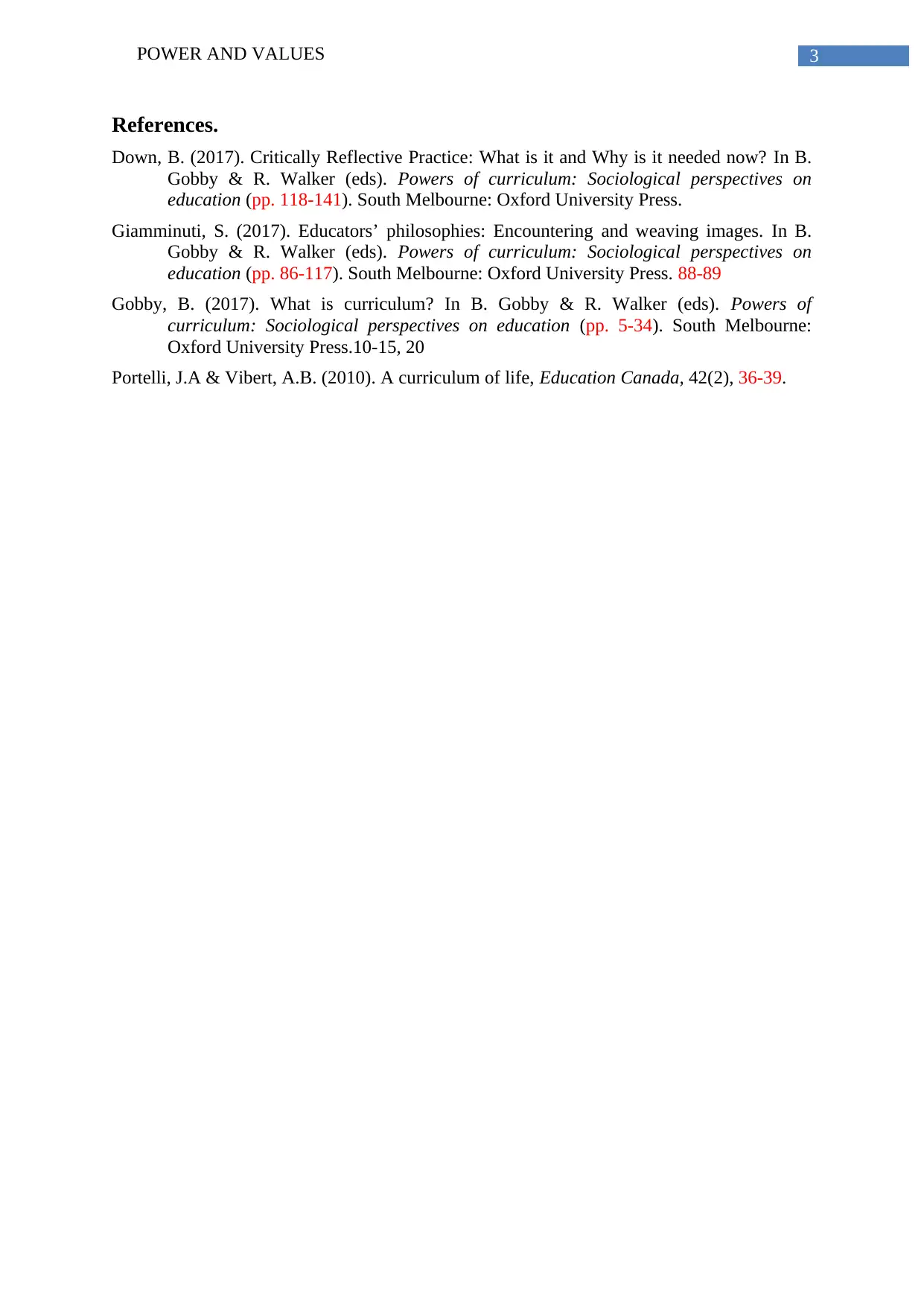Analysis of Power and Values in Curriculum and Learning
VerifiedAdded on 2022/08/31
|4
|1432
|44
Essay
AI Summary
This essay examines the multifaceted aspects of curriculum and learning, beginning with its political context and evolution in the Australian educational system. It explores the curriculum as a political tool and a product of socio-political influences, including the marginalization of specific student groups and the importance of cultural diversity. The essay differentiates between various curriculum types, such as intended, enacted, and hidden curricula, emphasizing their collaborative role in student development. It also explores the relevance of 'curriculum of life' and the role of educators, highlighting the importance of educators' philosophies, critical reflection, and the connection between pedagogical approaches and student experiences. The essay references key texts by Gobby & Walker, Portelli & Vibert, and Giamminuti to support its arguments and emphasizes the significance of teachers' self-reflection for more effective and holistic teaching practices.

Running head: POWER AND VALUES
POWER AND VALUES OF CURRICULUM AND LEARNING
Name of the Student
Name of the University
Author note
POWER AND VALUES OF CURRICULUM AND LEARNING
Name of the Student
Name of the University
Author note
Paraphrase This Document
Need a fresh take? Get an instant paraphrase of this document with our AI Paraphraser

1POWER AND VALUES
Topic 1
One of the most significant aspects that the text begins its understanding of
curriculum with, is the political background of the curriculum in the Australian context. What
Gobby and Walker (2017, pp 10 ) presents in the text is a thoughtful insight into curriculum
and deviation from the common, predominant understanding of the word. Curriculum in its
simplest meaning is an official document that refers to the subjects and relevant topics that
students are expected to learn in educational institutions, mainly school. For educators, a
curriculum acts a guideline for what to teach and what to exclude, whereas for students, a
curriculum is a framework for understanding subject knowledge. However, a curriculum also
serves as a source of information for educational objectives and outcomes that the students
are expected to meet and the educators are expected to help them meet.
The current text is an analysis of ‘curriculum’ from a variety of perspectives, starting
from a socio – political one. What has been understood from the initial sections of the text, is
that curriculum, has often been used as a political toolkit. In reverse, curriculum itself can
also be identified as a by – product of some form of socio – political propaganda, like Gobby
and Walker (2017, pp 15) highlights the case of the toolkit of learning resources funded by
the Safe Schools Coalition, as an effect of the wide spread marginalisation of LGBTIQ
students. Furthermore, a curriculum also takes the cultural diversity into consideration and
sets higher cultural competency as one of the significant learning outcomes.
Educators have been identified in the context as ‘intellectual workers’, given that they
play significant role in reshaping the mentality of students. Thus the prior knowledge base as
well as the beliefs and values that the educators hold becomes important factors for
consideration in the context, given that those beliefs significantly influence the learning
process and outcomes of the students.
Keeping all the factors in mind, there are six distinct types of curriculum which work
in tandem to help the students meet their learning outcomes (Gobby & Walker, 2017, pp 20).
The first is the intended curriculum which is the official curriculum that is specified for a
class, the enacted curriculum which is the portion of the intended curriculum dealt with in the
class, the negotiated curriculum is set after critical consideration of the receivers of the
curriculum (the students), the emergent curriculum which is built after taking a child’s
interests and strengths into account, the hidden curriculum where the learners learn things
outside of the stipulated curriculum by virtue of social associations and belonging and finally,
the null curriculum which is basically the portions worthy of being included in the intended
or enacted curriculum but deliberately omitted. What Gobby and Walker (2017, pp 13)
establishes their main point through the text is that, curriculum is a mix up of a variety of
factors and each of them work in collaboration to ensure the holistic development of the
learner.
Topic 2
Portelli and Vibert (2010, pp 37) presents a divergent view of the word ‘curriculum’
in the text ‘A Curriculum of Life’ whereby they establish the relevance of the title of the text
with the dynamic relationships that the teachers, students and the relevant knowledge share
with each other. Drawing correlation with Gobby and Walker (2017, pp 14), curriculum looks
at the content and establishes a series of outcomes for the students. Each of these outcomes
can be identified as what connects the student with the knowledge and what the educators
help the students achieve. There is a general conception that curriculum is equivalent to a
syllabus, and while it is true in some aspects, a curriculum also needs to take several other
Topic 1
One of the most significant aspects that the text begins its understanding of
curriculum with, is the political background of the curriculum in the Australian context. What
Gobby and Walker (2017, pp 10 ) presents in the text is a thoughtful insight into curriculum
and deviation from the common, predominant understanding of the word. Curriculum in its
simplest meaning is an official document that refers to the subjects and relevant topics that
students are expected to learn in educational institutions, mainly school. For educators, a
curriculum acts a guideline for what to teach and what to exclude, whereas for students, a
curriculum is a framework for understanding subject knowledge. However, a curriculum also
serves as a source of information for educational objectives and outcomes that the students
are expected to meet and the educators are expected to help them meet.
The current text is an analysis of ‘curriculum’ from a variety of perspectives, starting
from a socio – political one. What has been understood from the initial sections of the text, is
that curriculum, has often been used as a political toolkit. In reverse, curriculum itself can
also be identified as a by – product of some form of socio – political propaganda, like Gobby
and Walker (2017, pp 15) highlights the case of the toolkit of learning resources funded by
the Safe Schools Coalition, as an effect of the wide spread marginalisation of LGBTIQ
students. Furthermore, a curriculum also takes the cultural diversity into consideration and
sets higher cultural competency as one of the significant learning outcomes.
Educators have been identified in the context as ‘intellectual workers’, given that they
play significant role in reshaping the mentality of students. Thus the prior knowledge base as
well as the beliefs and values that the educators hold becomes important factors for
consideration in the context, given that those beliefs significantly influence the learning
process and outcomes of the students.
Keeping all the factors in mind, there are six distinct types of curriculum which work
in tandem to help the students meet their learning outcomes (Gobby & Walker, 2017, pp 20).
The first is the intended curriculum which is the official curriculum that is specified for a
class, the enacted curriculum which is the portion of the intended curriculum dealt with in the
class, the negotiated curriculum is set after critical consideration of the receivers of the
curriculum (the students), the emergent curriculum which is built after taking a child’s
interests and strengths into account, the hidden curriculum where the learners learn things
outside of the stipulated curriculum by virtue of social associations and belonging and finally,
the null curriculum which is basically the portions worthy of being included in the intended
or enacted curriculum but deliberately omitted. What Gobby and Walker (2017, pp 13)
establishes their main point through the text is that, curriculum is a mix up of a variety of
factors and each of them work in collaboration to ensure the holistic development of the
learner.
Topic 2
Portelli and Vibert (2010, pp 37) presents a divergent view of the word ‘curriculum’
in the text ‘A Curriculum of Life’ whereby they establish the relevance of the title of the text
with the dynamic relationships that the teachers, students and the relevant knowledge share
with each other. Drawing correlation with Gobby and Walker (2017, pp 14), curriculum looks
at the content and establishes a series of outcomes for the students. Each of these outcomes
can be identified as what connects the student with the knowledge and what the educators
help the students achieve. There is a general conception that curriculum is equivalent to a
syllabus, and while it is true in some aspects, a curriculum also needs to take several other

2POWER AND VALUES
factors into account, for instance family economic background. Portelli and Vibert, in their
text talks about an arts based school whose students mostly come from poor economic
backgrounds. The curriculum of life, as they state it, acts in favour of the students by
diminishing the line of demarcation that separates the school from the child’s real life
experiences (Portelli & Vibert, 2010, p. 36). A curriculum of life is therefore based primarily
on the experiences and expertise of the students, instead of enforcing what curriculum
builders think is appropriate for students at an age. That is where the power and values of the
curriculum is best expressed.
Topic 3
Despite the fact that teachers / educators are primarily responsible for weaving a
strong connection between the students and the curriculum, it would be unjust to consider
that the process is mechanical and devoid of any form of philosophy associated with
teaching. Giamminuti (2017, p. 88) brings the very aspect of educator philosophy to light by
highlighting that the educator’s philosophy is not stagnant, rather develops as the educator’s
own sets of beliefs and values develop through his own association and experience with the
teaching process, the learners, the culture and a variety of other factors. Down (2017, p. 120)
therefore establishes the importance of critical reflection in teachers as a crucial practice for
understanding what underpins the enacted curriculum. A teacher should not mechanically
follow the curriculum, nor should give absolute freedom to the children / students to do
whatever they want. Instead, their understanding should develop from what the learners are
picking up on the way. What Giamminuti (2017, pp. 88-89) explains in the text, the
development of a curriculum, especially in the early childhood setting, is heavily dependent
on the way the educator connects the pedagogical approach with the learners’ experiences
and choices. This is what helps the educators build their philosophy on as well.
A curriculum is overtly a document that supports the progression of learning in a well
- directed manner. However, the development of a curriculum is underpinned by several
critical factors like the educator’s philosophy, experiences with teaching, the learners’
personal attributes and proclivities, as well as social, political and cultural references and
correlations that the curriculum shares with both the educator(s) and the learners. This is also
the reason why Down (2017, p. 119) attempts to explain the significance of Critically
Reflective Practice (CRP). It allows the educators to look back on their teaching practices,
understand their own strengths and weaknesses and work on them accordingly, in order to
provide for a more rational and holistic teaching to the students, avoid attitudinal mistakes
that can be detrimental for the classroom and also develop a sound understanding of the
educator – learner relationship and how it should progress.
factors into account, for instance family economic background. Portelli and Vibert, in their
text talks about an arts based school whose students mostly come from poor economic
backgrounds. The curriculum of life, as they state it, acts in favour of the students by
diminishing the line of demarcation that separates the school from the child’s real life
experiences (Portelli & Vibert, 2010, p. 36). A curriculum of life is therefore based primarily
on the experiences and expertise of the students, instead of enforcing what curriculum
builders think is appropriate for students at an age. That is where the power and values of the
curriculum is best expressed.
Topic 3
Despite the fact that teachers / educators are primarily responsible for weaving a
strong connection between the students and the curriculum, it would be unjust to consider
that the process is mechanical and devoid of any form of philosophy associated with
teaching. Giamminuti (2017, p. 88) brings the very aspect of educator philosophy to light by
highlighting that the educator’s philosophy is not stagnant, rather develops as the educator’s
own sets of beliefs and values develop through his own association and experience with the
teaching process, the learners, the culture and a variety of other factors. Down (2017, p. 120)
therefore establishes the importance of critical reflection in teachers as a crucial practice for
understanding what underpins the enacted curriculum. A teacher should not mechanically
follow the curriculum, nor should give absolute freedom to the children / students to do
whatever they want. Instead, their understanding should develop from what the learners are
picking up on the way. What Giamminuti (2017, pp. 88-89) explains in the text, the
development of a curriculum, especially in the early childhood setting, is heavily dependent
on the way the educator connects the pedagogical approach with the learners’ experiences
and choices. This is what helps the educators build their philosophy on as well.
A curriculum is overtly a document that supports the progression of learning in a well
- directed manner. However, the development of a curriculum is underpinned by several
critical factors like the educator’s philosophy, experiences with teaching, the learners’
personal attributes and proclivities, as well as social, political and cultural references and
correlations that the curriculum shares with both the educator(s) and the learners. This is also
the reason why Down (2017, p. 119) attempts to explain the significance of Critically
Reflective Practice (CRP). It allows the educators to look back on their teaching practices,
understand their own strengths and weaknesses and work on them accordingly, in order to
provide for a more rational and holistic teaching to the students, avoid attitudinal mistakes
that can be detrimental for the classroom and also develop a sound understanding of the
educator – learner relationship and how it should progress.
⊘ This is a preview!⊘
Do you want full access?
Subscribe today to unlock all pages.

Trusted by 1+ million students worldwide

3POWER AND VALUES
References.
Down, B. (2017). Critically Reflective Practice: What is it and Why is it needed now? In B.
Gobby & R. Walker (eds). Powers of curriculum: Sociological perspectives on
education (pp. 118-141). South Melbourne: Oxford University Press.
Giamminuti, S. (2017). Educators’ philosophies: Encountering and weaving images. In B.
Gobby & R. Walker (eds). Powers of curriculum: Sociological perspectives on
education (pp. 86-117). South Melbourne: Oxford University Press. 88-89
Gobby, B. (2017). What is curriculum? In B. Gobby & R. Walker (eds). Powers of
curriculum: Sociological perspectives on education (pp. 5-34). South Melbourne:
Oxford University Press.10-15, 20
Portelli, J.A & Vibert, A.B. (2010). A curriculum of life, Education Canada, 42(2), 36-39.
References.
Down, B. (2017). Critically Reflective Practice: What is it and Why is it needed now? In B.
Gobby & R. Walker (eds). Powers of curriculum: Sociological perspectives on
education (pp. 118-141). South Melbourne: Oxford University Press.
Giamminuti, S. (2017). Educators’ philosophies: Encountering and weaving images. In B.
Gobby & R. Walker (eds). Powers of curriculum: Sociological perspectives on
education (pp. 86-117). South Melbourne: Oxford University Press. 88-89
Gobby, B. (2017). What is curriculum? In B. Gobby & R. Walker (eds). Powers of
curriculum: Sociological perspectives on education (pp. 5-34). South Melbourne:
Oxford University Press.10-15, 20
Portelli, J.A & Vibert, A.B. (2010). A curriculum of life, Education Canada, 42(2), 36-39.
1 out of 4
Your All-in-One AI-Powered Toolkit for Academic Success.
+13062052269
info@desklib.com
Available 24*7 on WhatsApp / Email
![[object Object]](/_next/static/media/star-bottom.7253800d.svg)
Unlock your academic potential
Copyright © 2020–2025 A2Z Services. All Rights Reserved. Developed and managed by ZUCOL.

